
Wolf spiders are members of the family Lycosidae. They are robust and agile hunters with excellent eyesight. They live mostly in solitude, hunt alone, and usually do not spin webs. Some are opportunistic hunters, pouncing upon prey as they find it or chasing it over short distances; others wait for passing prey in or near the mouth of a burrow.

Nursery web spiders (Pisauridae) is a family of araneomorph spiders first described by Eugène Simon in 1890. They resemble wolf spiders (Lycosidae) except for several key differences. Wolf spiders have two very prominent eyes in addition to the other six, while a nursery web spider's eyes are all about the same size. Additionally, female nursery web spiders carry their egg sacs with their jaws and pedipalps instead of attaching them to their spinnerets as wolf spiders do. When the eggs are about to hatch, a female spider builds a nursery "tent", places her egg sac inside, and stands guard outside, hence the family's common name. Like the wolf spiders, however, the nursery web spiders are roaming hunters that don't use webs for catching prey.
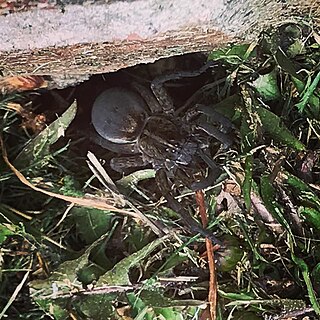
Tigrosa aspersa is a large wolf spider that inhabits the eastern United States. Compared to its close relative Tigrosa helluo, T. aspersa is much larger. This species was known as Hogna aspersa prior to 2012, when it was moved to Tigrosa.

Zoropsidae, also known as false wolf spiders for their physical similarity to wolf spiders, is a family of cribellate araneomorph spiders first described by Philipp Bertkau in 1882. They can be distinguished from wolf spiders by their two rows of eyes that are more equal in size than those of Lycosidae.

The Artoriinae are a subfamily of wolf spiders. The monophyly of the subfamily has been confirmed in a molecular phylogenetic study, although the relationships among the subfamilies was shown to be less certain.

Dolomedes scriptus is a fishing spider found in the United States and Canada, known as the striped fishing spider. Female spiders can grow to be over 6 cm in legspan. The spider is a pale brown colour with lighter stripes around its legs and a stripe down each side of the body. It is similar to D. tenebrosus.
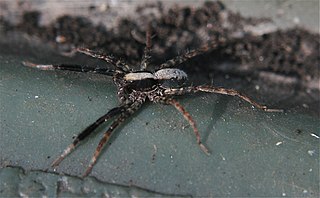
Schizocosa is a genus of wolf spiders containing around 60 species, distributed in North and South America, Africa, and East and Southeast Asia.
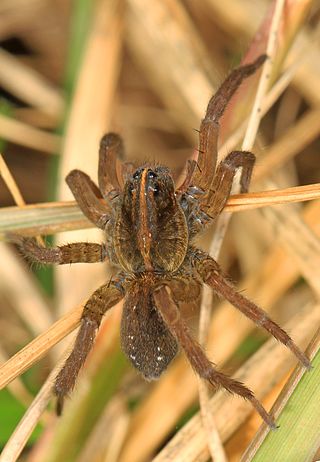
Tigrosa helluo is a species of spider belonging to the family Lycosidae, also known as wolf spiders. T. helluo was formerly known as Hogna helluo before differences between dorsal color patterns, habitat preferences, body structures, etc. were discovered. The species is native to the United States, Canada, and Mexico. It can be found across the eastern half of the United States, primarily in the Northeast and New England, and as far west as Nebraska and Kansas. T. helluo can be found in diverse habitats including woods, marshes, fields, and riparian areas. Typically, members of this species prefer to live in wetter areas as opposed to dry environments. Males tend to live for around a year and females will live for close to two years.

Tigrosa is a genus of spiders in the family Lycosidae, found in North America.
Varacosa is a genus of spiders in the family Lycosidae. It was first described in 1942 by Chamberlin & Ivie. As of 2017, it contains 6 North American species.
Melecosa is a genus of spiders in the family Lycosidae. Its lone species is found in Kazakhstan, Kyrgyzstan, and China.

Arctosa raptor is a species of wolf spider in the family Lycosidae. It is found in Russia, Nepal, the USA, and Canada.
Arctosa emertoni is a species of wolf spiders in the family Lycosidae. It is found in the USA and Canada.
Hogna baltimoriana is a species of wolf spider in the family Lycosidae. It is found in the USA and Canada.
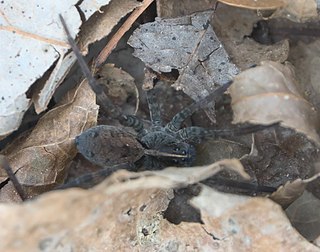
Tigrosa georgicola is a species of wolf spider in the family Lycosidae. It is endemic to the Southeastern United States. The type specimen was collected in Burke County, Georgia. Its habitat includes the forest floor of deciduous woodlands.
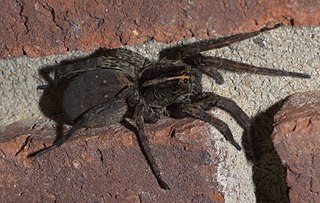
Tigrosa grandis is a species of wolf spider (Lycosidae) endemic to the United States, where it occurs from Montana, east to Missouri, and south to Texas.
Pardosa ramulosa is a species of wolf spider in the family Lycosidae. It is found in the United States and Mexico. The spider feeds primarily on prey near salt marsh habitat, and requires a varied diet.
Varacosa shenandoa is a species of wolf spider in the family Lycosidae. It is found in the United States and Canada.
Geolycosa xera, or Mccrone's burrowing wolf spider, is a species of wolf spider (Lycosidae) endemic to Florida in the United States.

Schizocosa mccooki is a species of wolf spider in the family Lycosidae. It is found in North America including Canada, the United States, and Mexico.













